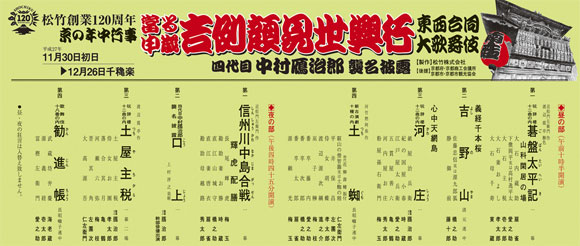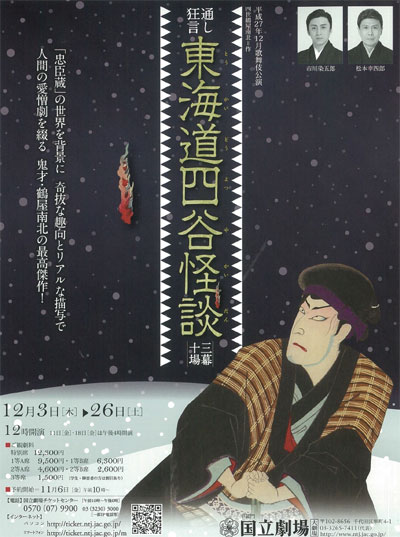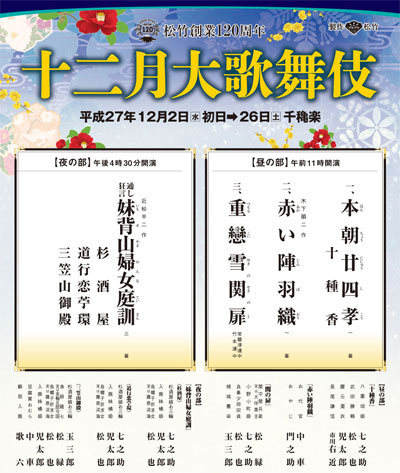| Comments |
The zagashira for these two programs of the December Grand Kabuki at the Kabukiza is Living National Treasure Band˘ Tamasabur˘.
The two highlights are the spectacular dance-drama "Tsumoru Koi Yuki no Seki no To" in the matinÚe program and
a t˘shi ky˘gen production of "Imoseyama Onna Teikin" in 3 acts in the evening program.
Regarding this t˘shi ky˘gen, the rarely-staged "Sugi Sakaya" act is revived. It was staged for the last time in June 1970 at the Minamiza.
Living National Treasure Band˘ Tamasabur˘ plays the roles of the courtesan Sumizome, in reality the spirit of Komachi's cherry tree, in "Seki no To" and Omiwa in "Mikasayama Goten".
The other star of this December Grand Kabuki is Nakamura Shichinosuke, who plays the roles of Princess Yaegaki, Ono no Komachi and Omiwa in "Jusshuk˘", "Seki no To" and "Sugi Sakaya"/"Koi no Odamaki".
Jusshuk˘: Princess Yaegaki is mourning the death of his fiance Katsuyori,
but as she burns incense in his memory, she notices the resemblance between the new gardener and her fiance's portrait.
The gardener is in fact Katsuyori, who has entered the household of Yaegaki's father to regain the
possession of a stolen family treasure, a famous helmet, with the help of Nureginu, a woman who also mourns for the man that died
in the place of the real Katsuyori. Unfortunately, Yaegaki's father has also seen through the disguise and plans to kill Katsuyori.
The role of Princess Yaegaki, one of the most important onnagata roles,
is played by Nakamura Shichinosuke, supported by Onoe Matsuya, Nakamura Kotar˘ and Ichikawa Ukon in the roles of Katsuyori, Nureginu and Nagao Kenshin.
Akai Jinbaori: the modern playwright Kinoshita Junji (1914~2006)
is known for his modern dances and plays based on Japanese folk stories.
This particular play shows a local magistrate who is inordinately proud of his red
battle jacket, until his pride gets a few hard shocks.
Starring Ichikawa Chűsha as the magistrate, with Ichikawa Monnosuke, Kamimura Kichiya and Nakamura Kotar˘.
Seki no To:
(The Snowbound Barrier)
A snow-covered barrier decorated by a mysteriously blooming cherry tree provides
the background for the larger-than-life story of a traitorous aristocrat
disguised as a barrier guard and the beautiful woman, actually a supernatural
spirit in disguise, that will defeat him. Living National Treasure Band˘ Tamasabur˘ (the keisei Sumizome, in reality the spirit of Komachi's cherry tree),
Onoe Sh˘roku (Sekibŕ, in reality ďtomo no Kuronushi), Nakamura Shichinosuke (Ono no Komachi) and Onoe Matsuya (Yoshimine Munesada)
star in what is considered to be one of the greatest Kabuki dance-dramas.
Imoseyama: "Imoseyama Onna Teikin", is a
masterpiece by Chikamatsu Hanji (1725~1783) first presented in 1771 in the
puppet theater. It is an epic taken from early Japanese history, weaving
together history, legend and myth. The country chafes under the domination of
the dictator Iruka. The two scenes from this epic classic show love and jealousy in a realm ruled by an evil dictator.
Sugi Sakaya:
(The Sugi Sake Shop)
The court nobles Fujiwara no Tankai (Onoe Matsuya) lives next to a sake shop
disguised as a craftsman named Motome. But all around are seeking a reward offered by Iruka for Tankai.
The handsome Motome is loved by two women: Princess Tachibana (Nakamura Kotar˘), who secretly visits him at night,
and Omiwa (Nakamura Shichinosuke), the daughter of the sake shop.
The two women argue over him and the princess leaves with Motome in pursuit and Omiwa following desperately after.
Featuring also Ichikawa Danko in the role of the apprentice Netar˘.
Michiyuki Koi no Odamaki:
(The Spool of Love)
Motome (Onoe Matsuya), the son of an important aristocrat opposed to the rule of the dictator Soga no Iruka is secretly
planning to kill him. Having disguised himself as a commoner, he has had nightly trysts with a mysterious woman,
an elegant princess (Nakamura Kotar˘). In this dance, he has attached a string to her kimono to follow her and discover
her identity. But Motome is followed as well by Omiwa (Nakamura Shichinosuke), the beautiful daughter of a humble sake shop owner
who has fallen in love with him during his time living undercover as a humble maker of court caps.
Mikasayama Goten:
(The Mikasayama Palace Scene)
The dictator Soga no Iruka (Nakamura Karoku) has set up his own court and now seeks to destroy his opponent Kamatari.
A mysterious fisherman named Fukashichi (Onoe Sh˘roku) comes as a messenger from Kamatari, claiming to bring a message of
surrender. Meanwhile, Iruka's younger sister, Princess Tachibana (Nakamura Kotar˘) has fallen in love with a handsome young man
named Motome (Onoe Matsuya). But Motome is actually the son of Kamatari and says that he will only grant her love if she will
cut off Iruka's head. Moreover, a country girl named Omiwa (Living National Treasure Band˘ Tamasabur˘) has also followed Motome. Omiwa's blood and the work
of all these people combined are what is necessary to finally defeat the magical powers of the evil Iruka.
Sources: Earphone Guide Website or Sh˘chiku Kabuki Official Website
|



